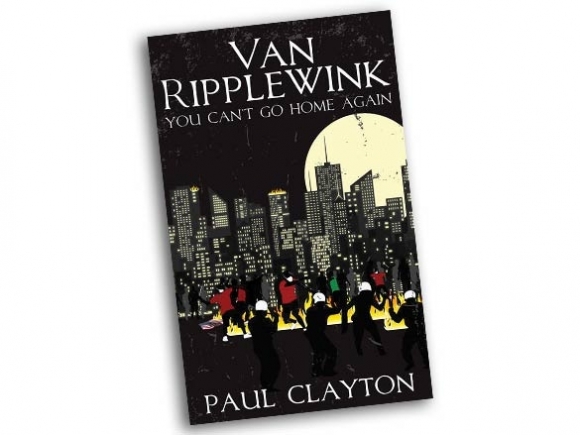Book delves into our lingering racial problems

“I refuse to accept the view that mankind is so tragically bound to the starless midnight of racism and war that the bright daybreak of peace and brotherhood can never become a reality ... I believe that unarmed truth and unconditional love will have the final word.”
— Martin Luther King, Jr.
“I’m not a race. I’m a person.”
That line from Paul Clayton’s Van Ripplewink: You Can’t Go Home Again surely sums up the dream of Martin Luther King from half a century ago. He and others envisioned an America where skin color no longer mattered, where all Americans were equal in the eyes of the law, where character and heart provided the criteria by which we were to judge our fellow human beings.
When James Earl Ray assassinated Martin Luther King, I was 17 years old, the same age as Van Ripplewink in Clayton’s novel. My family had moved from Pennsylvania to North Carolina when I was 5, to a town and a state where segregation still lived. “Whites Only” bathrooms and restaurants. Separate schools for blacks and white. Separate seating in the town’s movie theater. Even separate areas in the doctor’s waiting room, a restriction that was banished as soon as the town’s new physician, my father, began his practice.
Sometimes we don’t have the eyes or the consciousness to pause, look backward in time, and see where we once were. If we do take that moment, however, and examine the last half-century of our history, then Americans have much to be proud of. The evil practices of segregation were eliminated. In those 50 years, blacks won the right to vote, broke the color barrier in schools and universities across the South and Midwest, and rose to prominent positions in politics, including the presidency of the United States.
Related Items
Given these advances, many of us surely find it disheartening that race continues not just as a fractious issue for so many people, but that we can’t seem to get beyond it. Indeed, many of our politicians and members of the media, when viewed objectively, give the impression that they deliberately use race as a constant provocation, dividing the country into groups based on skin color and heritage, seeking the attention and the votes of blacks, white, Hispanics, or Asians en masse, as if skin color rather than common humanity makes us brothers and sisters. To lump constituencies together in such a ways is … well, racist.
Still, there is that line from the book. There is the dream. “‘I’m not a race,” Mignon sobbed. “I’m a person.”‘
In Van Ripplewink: You Can’t Go Home Again (Streetlight Graphics, 2016, 326 pages), Philadelphia teenager Van Ripplewink — the name derives, of course, from Rip Van Winkle — awakes from a 48-year coma. The year is 2015, and the old neighborhood of white working class families where he and his parents once lived has now become a battleground of gangs and drug dealers, blacks and Vietnamese. A confused Van sets out to find his old house, desperately looking for familiar faces, but with his Smith Brothers beard, his tattered clothing, and his pale skin, Van quickly attracts the attention of five young black men, who savagely beat him.
Rescued by Charles Davis, a black engineer working for the gas company, Van finds himself in a world he could scarcely have imagined: foreign cars that didn’t exist in the America of 1967, computers, cell phones, a plethora of drugs, street people, violent gangs. Even the language has changed, leaving Van to ponder such concepts as Java — wasn’t that slang for coffee? — and “white male privilege.” Using Van as our wide-eyed and often baffled guide, author Paul Clayton takes us from the trashy camps of the homeless to the editorial offices of a campus newspaper, from the peaceful life and meaningful work of Charles and his family to a full-blown racial riot, set off when the police shoot a young black man.
Van Ripplewink: You Can’t Go Home Again is not without flaws. Clayton fails, for example, to offer any valid explanations as to how Van survived his 48-year coma in a coffin. Many readers may also wonder why the young man didn’t search harder for his parents or tell someone his full story early on in the novel. Finally, Paul Clayton is a white male, and some on the PC patrol might deem his use of dialect as “cultural appropriation,” a term bringing great humor, incidentally, to those of us who enjoy eating Mexican or Chinese food.
That said, Van Ripplewink: You Can’t Go Home Again offers a superb look at race and race relations in today’s America. The characters are real and differentiated individuals. Charles Davis, rescuer of Van, and his beautiful niece Mignon, whose father was black and mother Vietnamese, live upper middle class lives, have white friends, and have escaped the venomous race rhetoric that has poisoned some whom they know.
Van eventually makes his own set of friends — Kang from Korea, Marco from the Philippines, Junior from West Virginia, and Chris the black middle-class youth torn between wanting to be with Mignon and life on the street. In the care and sympathy they show for one another, these young people give us a glimpse of Martin Luther King’s dream as reality.
In addition to Van Ripplewink, Paul Clayton has written a three-book historical series — Calling Crow, Flight of the Crow, and Calling Crow Nation — Carl Melcher Goes To Vietnam, and White Seed: The Untold Story of the Lost Colony of Roanoke.
(Jeff Minick is a writer and teacher. This email address is being protected from spambots. You need JavaScript enabled to view it..)









